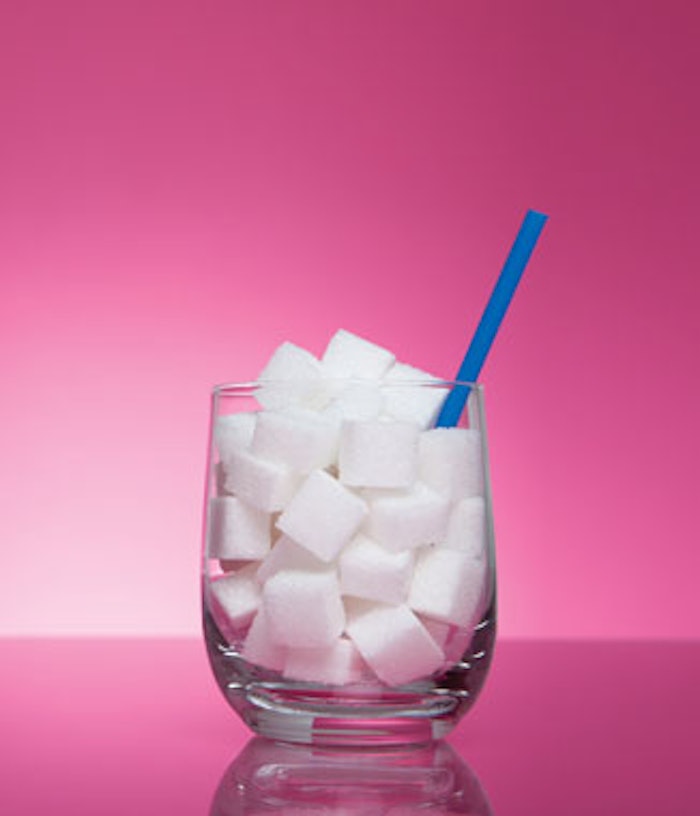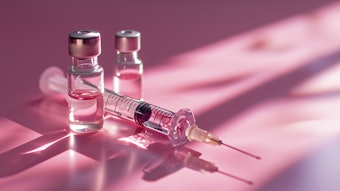
Over the past several years, there has been a lot of hype about glycation and advanced glycation end-products, or AGEs, as they’ve become known to the skincare world. Yet, with all the focus on glycation, much of this condition still remains a mystery to patients and scientists alike.
Part of the mystery stems from the lack of evidence tying specific aging reactions to glycation. With so many factors in our bodies and environment capable of breaking down collagen and elastin, isolating the cause and effect is challenging.
Yet, glycation is very real. Cross-linked proteins appear clearly under fluorescence in the presence of glucose, and incidence rates grow proportionately among diabetics. Many in the medical aesthetics field believe that preventing and overcoming the effects of this all-too common condition requires a combined outside-in and inside-out approach.
What Is Glycation?
Glycation occurs when sugar molecules, such as glucose, attach to a protein, resulting in a cross-linking of the protein. In the case of collagen—the most abundant protein in the skin—the sugar becomes enmeshed in the collagen, creating cross links that cause the skin’s protein to become stiff and brittle, says Nannan Chen, PhD, Scientific Affairs, Research & Innovation for La Roche-Posay (laroche-posay.us). Unlike the enzymatic process of glycosylation—an essential step in protein modification—glycation is a nonenzymatic, abnormal joining of sugars with proteins, notes Jeannette Graf, MD, board certified dermatologist, assistant clinical professor of dermatology at Mt. Sinai Hospital in New York, and author of Stop Aging, Start Living (Crown). Without the regulation of enzymes, the process becomes random and irregular, resulting in a loss of elasticity and weaker, thinner skin.
Internally, glycation plays a role in neurodegenerative disorders and atherosclerosis. In the skin it shows up under fluorescence testing specifically in the form of pentosidine, a biomarker for AGEs, says Dr. Graf.
Often referred to as the Maillard Reaction—named for the French chemist Louis-Camille Maillard, who first observed the effects of glucose and protein interaction—glycation affects the properties of the skin’s collagen and alters the skin’s extracellular matrix, thereby affecting cell migration, growth, proliferation and gene expression.
istockphoto.com
[pagebreak]
Who Is at Risk?
The more sugar there is in the body, the higher the incidence rate of glycation. For that reason, diabetics who do not manage their blood sugar through diet and exercise are at a greater risk than the average individual.
Those who eat a lot of white rice, flour, sugar and refined carbohydrates also are prone to developing the condition. “Foods that are high on the Glycemic Index scale quickly turn into sugar in the body,” says Michael York, president and CEO of Senté (sentelabs.com), a company that develops skincare products aimed at mitigating glycation-related damage in the skin.
According to Dr. Graf, glycation usually begins to set in at about age 35, and it accelerates with age. “As we age, we become insulin resistant,” agrees Charlene DeHaven, MD, FACEP, clinical director of Innovative Skincare (innovativeskincare.com) and an antiaging expert trained in internal medicine. “If you’re overweight, you’re more resistant,” she says. “Interestingly, except for severe obesity, age becomes more of a factor than weight after the age of 40.”
While the systemic effects of glycation are well-documented, the use of topicals to reverse or prevent glycation in the skin remains controversial. “Some of the ingredients that are being touted as anti-glycation are good, and we’ve been using them for 10 to 20 years,” says Rhonda Allison, founder and CEO of Rhonda Allison Clinical Skin Care (rhondaallison.com). “They can help with inflammation, and there is some talk of ingredients that act as MMP inhibitors, but we have to be careful to not make in-depth claims.”
Dr. Graf echoes this reluctance to link ingredients with hard-hitting anti-glycation claims. “Glycation is not just limited to the skin,” she says. “It’s a systemic problem. It’s not so much an outside-in problem as it is an inside-out problem.”
Can Topicals Help?
While diet can put the brakes on glycation by limiting the amount of free sugar in the bloodstream, skincare formulators are seeking topical ingredients that can help alleviate the damaging effects of glycation by fortifying the skin’s natural defense system and helping it to synthesize new collagen to replace what is lost to crosslinking. The science can be hard to track, as many processes, including normal free radical oxidation, all result in damage to the skin’s collagen. “It’s hard to tell clinically whether something is aged because of glycation or something else that may be going on,” says Dr. Graf.
One group of ingredients that has gained the most legitimacy in anti-glycation topical formulations is antioxidants, based on research, including “A Perspective on the Maillard Reaction and the Analysis of Protein Glycation by Mass Spectometry: Probing the Pathogenesis of Chronic Disease” (Quibin, Z, et al, J. Proteome Res. 2009, 8(2): 754-769), that linked glycation to oxidation.
DeHaven points out that antioxidants help fortify the body’s intrinsic antioxidant system. She recommends a good mix of oil and water-soluble choices. In particular, polyphenols such as catechins from green tea; resveratrol from red grape skin; and flavonoids, including pomegranates and blueberries. Gotu kola (centella asiatica) is another important anti-glycation ingredient purported to help stimulate collagen synthesis, DeHaven notes.
[pagebreak]
In addition to antioxidants, Dr. Graf favors carnosine, a building block of protein that can step in and block certain chemicals that play a role in the aging process.
La Roche-Posay’s DermAOX uses carnosine to help trap the glucose molecules that cause glycation by attracting the sugar molecules, thereby diverting the attraction away from the collagen fibers and thus protecting the skin’s matrix, says Chen.
In addition, anti-inflammatories are believed to help the skin defend against glycation by fighting the inflammation that results from free radical damage. The list of anti-inflammatory skincare ingredients is long: from resveratrol and licorice root to turmeric root extract, a potent anti-inflammatory that also protects the skin against free radical damage, according to Allison, who uses the herb in her Vitamin A+ Peptide Peel.
Other ingredients are used for damage control when MMPs, like collagenase, break down the collagen due to an overload of crosslinking. Innovative Skincare, for example, uses 4-hydroxyproline in its new SHEALD Recovery Balm.
“As we age, we become metabolically deficient in collagen synthesis. Our fibroblasts aren’t functioning like previously,” says DeHaven. “The 4-hydroxyproline helps stimulate the cells’ signals to make new collagen.”
[pagebreak]
Rhonda Allison’s Antioxidant Complex Serum features glycine soja (soy biopeptides), MMP blockers that promote fibroblast synthesis of new collagen and elastin; L-glutathione, an enzyme that protects fibroblasts and cells from free radicals; and L-Super Oxide Dismutase (SOD), an enzyme and potent antioxidant that helps prevent tissue respiratory oxygen from forming oxygen free radicals.
Senté’s Dermal Repair Cream contains heparan sulfate, a building block of skin that depletes with time and environmental damage. “The molecule works with stem cells and binds to growth factors in the skin to help with collagen synthesis,” York notes. Heparan sulfate—an antioxidant as well as a glycosaminoglycans (GAGs)—can hold 1000 times its weight in water to hydrate the skin. Originally used by burn centers in Switzerland for wound healing, the active has produced preliminary data showing its aptitude for improving fine lines, tone and texture, and leading to gradual skin lightening after one month of use, says York.
In a company white paper, researchers detail how penetration of the epidermis by a low molecular weight 1% heparan sulfate has demonstrated the ability to induce profound rehydration and antiaging effects. In addition, a 2012 study published in the Journal of Biological Chemistry (Kraushaar, DC, et al, J Biol Chem May 3, 2012) reported heparan sulfate’s ability to facilitate growth factor-mediated mesoderm differentiation in embryonic stem cells. The active plays a key role in tissue regeneration following injury and may provide valuable triage to aged cells ravaged by the effects of glycation.
Aminoguanidine is a promising ingredient that has nitric oxide-inhibiting activity and may help diminish the end products of glycation by preventing the sugars from sticking to the skin tissue, says Dr. Graf. Research suggests that aminoguanidine most likely operates on more than one step of the Maillard cascade (Khalifah, et al, “Amadorins: Novel Post-Amadori Inhibitors of Advanced Glycation Reaction,” Biochemistry, April 13; 257(2); 251-8).
Aminoguanidine has been used investigationally for diabetic neuropathy but has not been developed into a topical, though some skin labs are working with the ingredient in development, Dr. Graf notes. For instance, in in vitro assays of human serum albumin as a test protein mixed with glucose, Mibelle AG Cosmetics reports that the addition of aminoguanidine resulted in 90% inhibition of the formation of glycation end products after four weeks. A similar effect occurred with an antioxidant mixture comprised of grape seed extract and tocopherols.
Both aminoguanidine and the antioxidants seem to help prevent protein glycation by blocking the conversion step of early glycation into AGEs. Glycation is an inevitable consequence of aging, but you can help patients stave off the collagen-altering and stiffening effects by taking a multi-pronged approach through diet, exercise and well-selected topicals.
Andrea Sercu is a freelance writer based in the San Francisco Bay Area.











